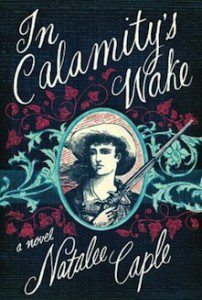
Described by its author as a “work of metahistoriographic fiction,” In Calamity’s Wake is an intriguing novel of longing, adventure, and chance encounters. Natalee Caple constructs a narrative from myriad sources about infamous frontierswoman Calamity Jane, shaping her novel around the journey of Miette, Calamity Jane’s daughter, to find the mother she’s never known. Caple has collected myths and anecdotes about Calamity Jane–whose life story remains largely speculative–and she stitches them together in an authentic and haunting portrait of the legendary ‘heroine of the plains.’
In Calamity’s Wake alternates between Miette’s journey to find the mother who abandoned her, and Martha Canary’s evolution from a curious and compassionate child into the infamous Calamity Jane. When Miette’s father is on his deathbed, he asks Miette to swear that she will search for her mother once he has died. Miette obliges, but she admits, “I had no intention of keeping my promise […] she meant less than ashes to me.” But Miette is swiftly compelled to find her mother, a transformation that Caple renders with vivid prose: “But with my father’s death, what happened and what was only an occurrence of feverfish, bright creatures of grief-fueled fantasy, all began to swim at the same speed.” Caple’s language is at once lush and precise, straddling magical realism and cowboy romance. As Miette is traveling, her vision is “blued” by bushes of lilac; a young girl describes being raped as having “so much bad courage in the dark”; Miette travels across the country on horseback and witnesses “an immense murmuration of starlings [spinning] across the horizon. The birds were a flowing black powder, thousands together in a wave taking on the shape of one much greater thing, a hand reaching down from the sky to conduct music.” While both Martha and Miette are stoic survivalists, their language reveals their lust for the wild frontier and the ecstasy of independence.

It is impossible to discuss In Calamity’s Wake without exploring the other texts that hover over Caple’s narrative. In Calamity’s Wake presents its first surprise in its opening sentence: “I came to the Badlands because I was told that my mother, a woman named Martha Canary, lived there.” Readers familiar with Pedro Páramo, Juan Rulfo’s 1955 landmark surrealist novel, will recognize this construction from the opening line of Rulfo’s text: “I came to Comala because I had been told that my father, a man named Pedro Páramo, lived there.” I recently read Pedro Páramo for the first time, and I was struck by the similarities in Caple’s sentences and narrative in the early chapters of the book. Caple not only transposes Rulfo’s construction onto her own sentences, but also replicates entire scenes nearly word-for-word. In her “Note on Pastiche Sources,” Caple acknowledges that Pedro Páramo “influenced the early chapters of the book,” and goes on to explain that many of her characters speak in sentences borrowed from existing historical documents. As a historical figure, Calamity Jane is a cipher, a woman of legend and myth, and so Caple has decided to create her character from a collage of oral histories, anecdotes, historical records and folk wisdom. Less clearly justified, though, is Caple’s decision to borrow sentences as well as a broader narrative shape from another work of fiction. While the scenes lifted from Pedro Páramo contribute a compelling, haunted atmosphere, Caple’s writing truly shines when she diverges from her loyalty to Rulfo’s novella after the opening chapters. But some may argue that In Calamity’s Wake is a true pastiche as it stitches together unusual and unpredictable sources to create a cohesive narrative.
While the direct and unattributed quoting from Pedro Páramo is jarring, Caple’s decision to transpose Rulfo’s novel onto a woman’s journey to the badlands makes for a fascinating meeting of worlds. Caple draws a parallel between Calamity Jane and the legendary Pedro Parámo–both ghosts, both more myth than human, both the objects of their lost children’s curiosity and longing–and so elevates Miette’s quest for her mother to the realm of myth. As Miette travels, she is haunted as much by her dead father as she is by the specter of her mother, and all those who claim that Calamity Jane is nothing but a work of fiction: “In the hours that passed I began to hear voices, the Hag saying, Yes, I nearly was your mother, didn’t you know? The man on the trail saying, She’s living, moving, humping bile! My father saying the Rosary, asking for the forgiveness of sins and the resurrection of the flesh. I heard beads clicking as they rolled against one another.” Caple’s prose crackles with life in this novel, each sentence a stunning incantation as Miette travels an ever-shifting path.
While Caple interacts with other texts–ranging from primary sources to Pedro Páramo to Jules Verne’s Five Weeks in a Balloon–her most impressive leaps are not in her narrative collage, but rather in the construction of big-hearted, complex, and fiercely strong female characters. Caple builds the scaffolding for the novel out of immense mythologies, but her true achievement is the grace, brutality, and poetic precision with which she draws out characters: “Hear this,” Martha tells us. “I can’t freeze to death nor can I drown. I tried poison but it only nourished me.” Caple’s characters are built for survival, and their voices ring out from the page as audacious, enduring battle cries.




